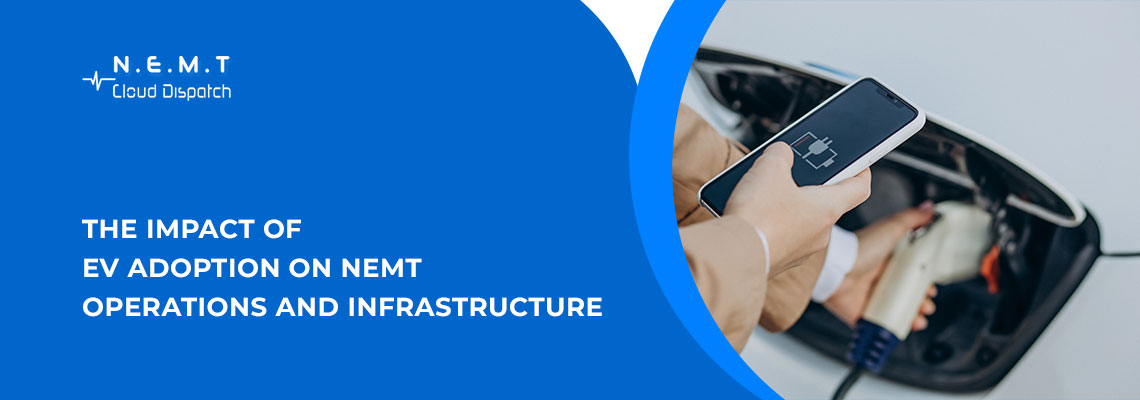The rise of electric vehicles (EVs) is transforming many industries, including Non-Emergency Medical Transportation (NEMT). With governments and organizations pushing for sustainable and eco-friendly solutions, EV adoption is becoming more prevalent. But what does this mean for NEMT operations and infrastructure? At NEMT Cloud Dispatch, let’s explore the opportunities, challenges, and long-term impacts of EV integration in the NEMT industry.
Environmental Benefits of EVs in NEMT
One of the primary reasons for adopting EVs is their environmental advantage. EVs produce no tailpipe emissions, reducing air pollution and contributing to cleaner cities. For NEMT, this aligns with the broader goal of creating a sustainable transportation system.
Reduced Carbon Footprint: NEMT providers using EVs can significantly lower their carbon emissions, supporting global and local sustainability goals.
Positive Public Perception: Patients and healthcare facilities may prefer NEMT services with environmentally friendly fleets, improving business reputation and customer loyalty.
Cost Implications for NEMT Providers
Cost is a critical factor in the NEMT business, and EV adoption brings both opportunities and challenges:
Lower Operating Costs
EVs use electricity instead of gasoline, reducing fuel costs. Over time, these savings can offset the higher initial purchase cost of EVs. EVs have fewer moving parts compared to internal combustion engine (ICE) vehicles, leading to lower maintenance costs.
High Initial Investment
EVs tend to have a higher upfront cost than traditional vehicles, which can be a barrier for small to mid-sized NEMT providers. Installing charging stations at depots or strategic locations requires significant investment.
Incentives and Grants
Governments often provide financial incentives, tax credits, or grants for purchasing EVs and building charging infrastructure. NEMT providers should explore these options to reduce the financial burden.
Impact on Daily Operations
Switching to EVs can significantly alter how NEMT providers operate.
Range and Trip Planning
EVs have a limited range on a single charge, which can be a concern for long-distance trips. NEMT providers must carefully plan routes to ensure the vehicle has enough charge for round trips. Unlike refueling a gas vehicle, charging an EV takes time, which may impact the number of trips a driver can complete in a day.
Fleet Management Adjustments
Providers will need to schedule trips around charging times to avoid service delays. Using advanced route optimization software integrated with charging station locations can help minimize disruptions.
Training for Staff
Drivers and fleet managers must be trained on:
- Operating EVs efficiently.
- Understanding charging processes.
- Handling EV-specific issues, such as finding charging stations during emergencies.
Infrastructure Changes
The adoption of EVs in NEMT requires significant infrastructure adjustments.
Installing charging stations at fleet depots ensures vehicles are ready for daily operations. Collaboration with local governments and private companies to expand public charging networks is essential for seamless operations.
Integration with Healthcare Facilities
Some medical facilities may need to install charging stations to accommodate NEMT EVs during patient pickups and drop-offs. Widespread EV adoption will increase electricity demand. NEMT providers may need to work with local utility companies to ensure the grid can handle this additional load, especially during peak hours.
Technology and Software Integration
EV adoption in NEMT also emphasizes the need for advanced technology and software systems.
Fleet management software should monitor EV battery health and charge levels to ensure vehicles are ready for trips. Advanced scheduling systems can consider charging needs, trip durations, and charging station locations.
Telematics Integration: Real-time tracking of EV performance can help in predictive maintenance, avoiding unexpected breakdowns.
Challenges Unique to NEMT
NEMT services face unique challenges when adopting EVs due to the nature of their operations:
- Accessibility Features
- Emergency Preparedness
- Regulatory Compliance
Opportunities for NEMT Providers
Despite the challenges, EV adoption offers several opportunities for NEMT providers:
Market Differentiation: Offering eco-friendly transportation can be a unique selling point, especially for healthcare organizations prioritizing sustainability.
Long-Term Cost Savings: Over time, lower operational costs and reduced reliance on fossil fuels can improve profitability.
Technological Advancements: The shift to EVs often comes with adopting advanced fleet management tools, improving overall efficiency.
Fleet management solution by NEMT Cloud Dispatch
Choosing the right fleet management solution for your NEMT business is a critical decision that can impact your operational efficiency, customer satisfaction, and overall success. NEMT Cloud Dispatch Fleet Management Software offers a comprehensive set of features tailored to the unique demands of NEMT businesses, making it an excellent choice for enhancing your fleet management capabilities.
Conclusion
The adoption of electric vehicles in NEMT operations offers a mix of challenges and opportunities. While the initial investment and infrastructure changes can be significant, the long-term benefits, such as lower operating costs, reduced environmental impact, and improved public perception, make it a worthwhile endeavor. By carefully planning and leveraging available incentives and technology, NEMT providers can ensure a smooth transition to EVs and position themselves as leaders in sustainable healthcare transportation.


